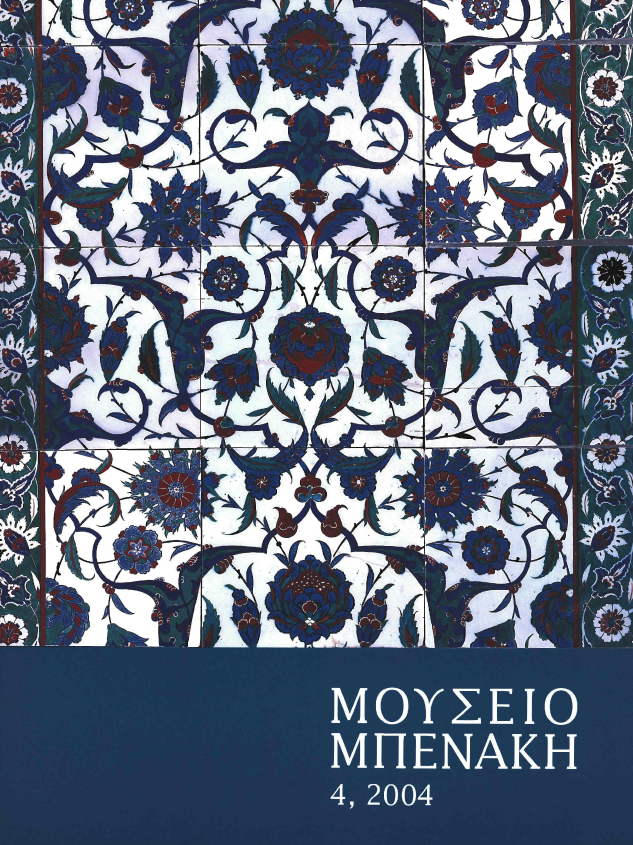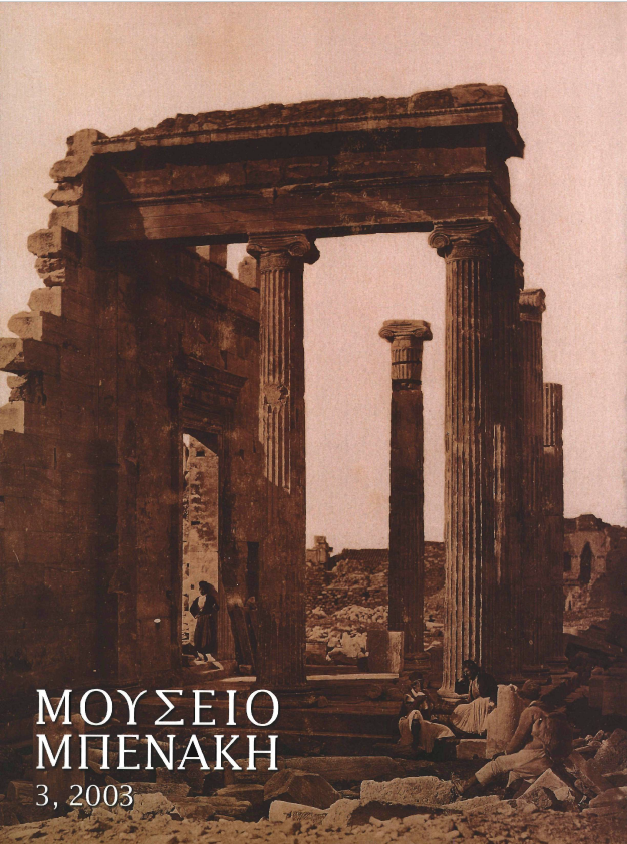Glass medallions with religious themes in the Byzantine collection at the Benaki Museum: technical analysis
Abstract
The nine glass paste medallions in the Benaki Museum, examples of the minor arts of the mediaeval period, were subjected to examination in connection with the article by Vasiliki Foskolou: this involved visual observation, study of the microstructure and chemical analysis and aimed at confirming as far as possible that the resulting data was consistent with the historical arguments. A detailed study was made of five of the medallions (inv. Nos 13546, 13525, 13522, 13524 and 13523), which were selected on the basis primarily of size and shape and secondarily of colour, taking into account the gradations and individual qualities which each object presented. For this purpose it was necessary to investigate the production techniques and to determine the quality and quantity of the components. Instruments used in the analysis were the stereoscope, the metallographic microscope and the electron scanning microscope (SEM). The medallions were manufactured by the process of casting in a mould, and were made of mixed alkali glass (potassium, sodium, lime and silica) which falls into the category of potassium-rich forest-ash-glasses. Glasses of this composition were widespread throughout Northwest Europe from the 8th-9th century A.D., while in the East there was a parallel use of plant-ashbased soda glasses, as substitutes for the earlier natronbased soda glasses. The source of the colour in the medallions was copper. This copper colouring technique was considered in antiquity as among the most demanding. They fall within the category of red glasses with low or non-existent lead content, which are dull, darkish red (liver-coloured), by contrast with red glasses with a high lead content (up to 24%), which are bright sealing wax red. They also display an opacity which classifies them as dim red-brown glasses. These glasses reproduce the colour and form of cameos, precious and semi-precious stones, which we have come across in other periods with a parallel use of other metal oxides such as iron, manganese and lead. The copper: lead ratio is associated with a type of red glass which was fairly widespread -mainly in the 1st millennium B.C., since glassmakers afterwards recognized the superior qualities of lead and aimed to exploit them through the production of glass with increased lead content. However, though there is more frequent reference to red glass with a high copper and lead content in later periods, indications can be found of a parallel use of other combinations of these two metal oxides and of glasses with variable intermediate concentrations. This last category includes mediaeval potassium glasses which were prevalent in 12th-century Europe. This category also includes the Benaki Museum medallions. The absence of lead generally, in spite of its known qualities, can be attributed to the shortage of red glass or suitable litharge or slag for the manufacture of the glass (from the point of view of the use of secondary product). However in the case of the medallions it could have been deliberate, with the aim of the achieving a close resemblance to specifically designed minerals and semi-precious stones, as well as an increased output of objects of lower expense and quality to be used as pilgrim tokens. On the other hand the small content of lead which has been traced in certain medallions might be attributable to its entirely fortuitous introduction through the use of secondary products, a process which is associated with other oxides in the composition of the glass from which they were made. The components of the medallions' colour, when taken with those of their glass, suggest that they were produced in the West, and this accords with the relevant historical data. The results of the chemical analysis again provide strong support for the attribution to Venice, or perhaps its wider region, as the specific area of manufacture. The truth is that there are certain indications of the production not only of two different components (potassium and soda) but also of two different qualities of glass. As regards quality, one group of glasses displays good discolourising agents, and the second poor discolourising agents: these variations derive from the nature and the purity of the primary materials and from the refining process (for example, the lower quality of the source of the silica or manganese). To the question whether both the composition and the colouring of the medallions derives from secondary products the answer is probably affirmative. As regards to the colouring, it probably derives from secondary products rich in copper. The bibliography states that at this period red glass or red enamel had close associations with the metallurgical industries rather than with the production of glass itself. This view is based on the difficulty of colouring glass by adding copper in the form of metal. For this reason copper was added in the form of a substance which could be dissolved and integrated more easily and quickly in the metal glass. Either a certain grade of copper was used by the metallurgical industries or the glassmaker simply heated in the crucible particles of metal (whether introduced or not) to the point of oxidisation and then crushed and dispersed them in the metal glass or placed opaque metal glasses of two different shades in the same crucible and stirred them so as to create a new blend. The last two instances are perhaps the most relevant to the colouring of the Benaki Museum medallions, since no traces were found of other elements such as silver, gold, zinc or tin, which are more directly associated with the by-products of the metallurgical industries; while lead, which is also a feature of metallurgical materials of this type, is either absent or minimal in quantity, so that its presence may be explained as a contaminant in the recycling process. The same may apply to iron or manganese. The complexity of the production of such glasses which contain a group of different metal oxides of varying content, composition and now lost techniques (which according to the bibliography were limited to small groups of glass-workers or to families), makes it difficult to approach the problem of the provenance of such glasses and the location of a specialised factoiy. It is also hard to respond with any certainty to questions concerning the use of a metallurgical secondary product or a recycled or primary product or a commercially acquired product, in combination with the deliberate or unconscious additional element of skilful or unskilled handling by the glass-maker. The historical evidence presented above, the common technical production features and the uniformity of the results of the analysis of the basic metal oxides in the composition of the glass and the colouring, attest to a common area and place of manufacture. The most productive source of further reliable information is likely to be the study of glasses from other areas of the mediaeval world and an examination of similarly produced glasses of later periods, which involved comparable conditions of heating, blending and admixture in red glass manufacture. Research and documentation of the production and composition of further red glasses from other regions of the mediaeval world will allow further and better attested responses to the questions which still remain unanswered.
Article Details
- How to Cite
-
Κοτζαμάνη Δ. (2018). Glass medallions with religious themes in the Byzantine collection at the Benaki Museum: technical analysis. Mouseio Benaki Journal, 4, 75–89. https://doi.org/10.12681/benaki.18280
- Issue
- Vol. 4 (2004)
- Section
- Articles

This work is licensed under a Creative Commons Attribution-NonCommercial-ShareAlike 4.0 International License.
The copyright for articles published in Mouseio Benaki is retained by the author(s), with first publication rights granted to the journal. By virtue of their appearance in this open access journal, articles may be used freely for non-commercial uses, with the exception of the non-granted right to make derivative works, with proper reference to the author(s) and its first publication. The Benaki Museum retains the right to publish, reproduce, publicly display, distribute, and use articles published in Mouseio Benaki in any and all formats and media, either separately or as part of collective works, worldwide and for the full term of copyright. This includes, but is not limited to, the right to publish articles in an issue of Mouseio Benaki, copy and distribute individual reprints of the articles, authorize reproduction of articles in their entirety in another publication of the Benaki Museum, as well as authorize reproduction and distribution of articles or abstracts thereof by means of computerized retrieval systems.



